
The internet has become an integral part of our daily lives - even moreso since the pandemic made remote work more widespread, but let's be honest: this change was coming one way or another. Unfortunately, this isn't easy for all Australians, many of whom frequently complain of poor home internet service. This can be a major problem, especially when careers and the quality of life hinges more on that connection than ever: the last thing you want is to turn into a pile of pixels in the middle of a crucial work meeting, or have a movie stall when you're trying to spend quality time with your partner.
If you're looking for that easiest way to get 1000 mbps internet, we've got you covered - hopefully better than the NBN, anyways!
Understanding the NBN
The National Broadband Network (NBN) is the primary infrastructure providing internet access to Aussie homes and businesses. But not all NBN connections are created equal - if you're having trouble with the NBN, you should check your coverage type here; if you're on FTTN, you may want to look at some of the alternatives we mention below. But before we get into those, what do those acronyms even mean?
Fibre to the Premises (FTTP)
Fibre to the Premises (FTTP) is considered the gold standard of NBN connection types. FTTP means you have a dedicated fiber line running straight to your home. That means that you'll pretty much always have a fast connection, although how fast that is will still depend on your provider and the plan you choose. But we'll get into that later.
mmMany places with FTTN connections are becoming eligible for FTTP upgrades; sometimes its expensive, but if you're dealing with a slow connection at the moment, it's worth checking with the NBN Co to see if your address is eligible to upgrade.
Fibre to the Node (FTTN)
Fibre to the Node (FTTN) utilises a mix of fibre and copper lines. Fibre is used to connect a Node in your neighborhood to the NBN, and then old-style copper cables connect individual homes to that Node. This means that, if you're on FTTN, you're essentially sharing a fibre connection with your neighbors. This means your connection speeds will never be great, and they might vary wildly depending on the time of day and the types of activities your neighbors get up to on the web - if someone is mining bitcoin on your block, you're not gonna have a good time sharing a fibre line with them! If you have FTTN, you likely shouldn't bother paying extra for a higher-tier NBN plan; if the basic NBN25 plan doesn't cut it for you, you may want to look into alternatives like 5G or satellite.
Hybrid Fibre-Coaxial (HFC)
Hybrid Fibre-Coaxial (HFC) works a bit like FTTN, but instead of using old copper phone lines, HFC uses coaxial lines, like those used for pay TV connections. These are generally better than FTTN, but the speeds can still vary depending on how many other addresses are running on the same node. A bit like having a bigger straw going into the same drink, having HFC means you'll still usually have better speeds than your neighbors on FTTN, even if you're on the same node, because they can only use up so much of that bandwidth no matter how much they use or pay. Still, it's not as good as FTTP, and you may still find you have a bit of lag if you're frequently streaming HD on multiple screens, or have more than one person working from home on Zoom calls, uploading big files, etc, even if you pay extra for NBN100.
Fibre to the Curb (FTTC)
Fibre to the Curb (FTTC) is a newer technology where fibre is run to a distribution point near your premises, and then copper completes the final leg of the connection to your home. This isn't as bad as FTTN because the length of the copper wire used is shorter, and you still have fiber coming off the node, meaning your connection doesn't have an inherently lower priority than that of your neighbors running on FTTP or HFC. This type of connection is just fine for most people, but, like HFC, you may occasionally have a bit of lag during periods of high usage.
The Rise of Wireless Home Internet

If you're being dragged down by your neighbors on FTTN and live in an area with really strong mobile coverage, you may yet be in luck. Every day, new 5G towers and satellites are going up, bringing high speed connections to people who might have waited forever for the NBN Co to get them a serious connection. It's definitely worth checking out what's a available in your area
5G: The New Kid on the Block
Some telecoms have begun offering 5G Home Internet service in urban areas, which is often superior to slower NBN connection types. These services work just like a standard home internet connection, but instead of plugging into the NBN lines, your connection comes straight from a tower, just like a mobile phone. This requires a special type of modem optimized for 5G service. Unfortunately this service type isn't as widespread as it should be, since mobile operators want to prioritize their mobile customers, and only offer 5G Home Internet in areas where the mobile 5G network has bandwidth to spare.
If your telecom isn't offering 5G at your address, there might be a way around. Most telecoms offer 4G/5G mobile internet, a portable connection used with devices that are intended to provide a small-scale wifi connection. These devices are normally used by people who work on the go who want to connect multiple devices to a wifi network that they can take with them anywhere. Unlike 5G home internet connections, this service is generally available anywhere that decent mobile service is available. The downside is that these connections are often subject to data caps or throttling, and the range on mobile hotspot devices is often limited, although some manufacturers like Netgear offer solutions that can help work around this problem. This might be a viable option if you're out of luck with all of the above, and satellite is out of your price range, but you've got decent mobile service in your home.
Reaching for the Skies
For those living in regional Australia who are often plagued by poor NBN and mobile connections, satellite might be your final hope. NBN's Sky Muster service offers satellite internet, but that service comes with limitations on speed and data allowance, while normal NBN connections offer unlimited data. Luckily, private companies like SpaceX's Starlink are bringing faster speeds and no data caps, albeit at a higher price. If you can afford it, this might just be the way to go if you're dealing with the regional internet blues.
Pulling Your Weight

For better or for worse, it's not always the NBN's fault. Sometimes you may have a perfectly good home connection, or may have already shelled out for that fancy Starlink connection, but you just can't seem to get reliable WiFi throughout the house. Unfortunately this may not be a problem with your service, but with your home and the hardware you're using.
Most modems provided by NBN wholesalers are basically the bare minimum they can offer that will keep most people out of the complaints queue. That's not great of them, but it's also not their problem; standard modems work just fine for people in small houses and apartments. If you have a large home (or a large family), your home network may require a few upgrades to get you up and running properly - it may save you a lot of time and stress compared to waiting for your case to hit a Telstra employee's inbox, only to come back with nothing helpful.
If you're on FTTP, FTTC, or HFC, and still can't get a decent connection, you may want to think about upgrading your modem before you bother switching companies or shelling out for that fancy Starlink install. If you're using your connection for serious business, or have more than 3 or 4 people running on the wifi at a time, or even if you've just had the same modem for 5+ years, upgrading your modem might be worth your time and money. Ask your provider, and if the one you've got is the one they're offering, it may be worth a look in JB HiFi to check out the latest Netgear Nighthawk model
If the laptop you have right next to the router is slow as molasses, that's one thing, but if you're trying to stream 4k video 10 meters from your modem, or if your NBN box is in the garage and your office just happens to be on the opposite side of the house, you may want to invest in a mesh wifi network (also known as boosters or extenders) to see if expanding and strengthening your network might help out. Most wholesalers will be happy to sell you boosters that are highly compatible with the modems they give out, and if you're not happy with their offer, Google and Netgear makes some very popular, highly effective mesh wifi systems that should pair well with just about any modem or router.
There's no one guaranteed way to fix every internet connection - it's going to take a little research on your end about what kind of connection you have right now, what's available in your area, and what kind of hardware you need to get a good connection throughout your home. That said, if you try everything we've suggested here, we're hoping you'll find what you need to get yourself the upgrade you deserve, because having a high quality internet connection really does make a difference! And hey, who knows, maybe with competition coming from Starlink and 5G home internet, hopefully the NBN will stop resting on its laurels and start rolling out real upgrades to its fixed and wireless networks once and for all!
ⓒ 2025 TECHTIMES.com All rights reserved. Do not reproduce without permission.




